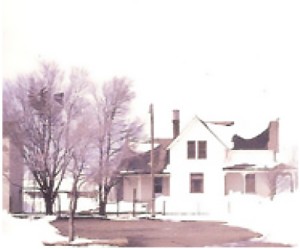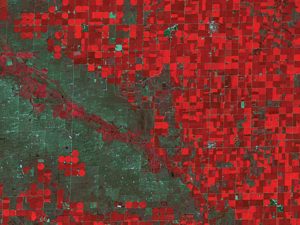Above Featured Image: An intricate maze of small lakes and waterways defines the Yukon Delta at the confluence of Alaska’s Yukon and Kuskokwim Rivers with the frigid Bering Sea. Wildlife abounds on the delta and offshore, where sheets of sea ice form during the coldest months of the year. ASTER image taken Jan. 1, 1999. Image courtesy of U.S. Geological Survey, Earth Resources Observation and Science Center.

Myrna James Yoo
Publisher: Apogeo Spatial (formerly Imaging Notes)
and LBx Journal
Owner: Blueline Publishing LLC
Thank you for reading Apogeo Spatial! I am full of gratitude for your participation, whether it’s as a reader, a contributor, a company that invests with advertising, or any advocate of Earth observations. We are so fortunate to work in a field where our efforts make a tangible difference in many ways and to all our lives every day.
Earlier this year, we introduced our strategic alliance of geospatial publications, the Location Media Alliance (LMA; www.locationalliance.net).
We have quarterly editorial themes that we address in each of our five publications (Apogeo, Sensors & Systems, Informed Infrastructure, LBx Journal, and Asian Surveying & Mapping). The current theme is energy.
In this issue, we cover energy with a story about wind farm siting beginning here. Over a decade ago, I told my dad, a farmer in Kansas, that we should invest in wind energy out there on the plains. We lived for a time on his father’s farm, complete with an old non-functioning windmill and well house (see photos).
Growing up, I heard about crop prices, dependence on the weather, and the importance of water. Dad sold the farm water rights from the Ogallala Aquifer to my hometown, Hoxie. These aquifers around the world are being drained and stressed. Some estimates indicate that we have as little as 25 years left relying on this source of water. (Our Spring theme was water; read about water sensors by downloading it here)
While wind is a positive factor for energy generation, it can turn negative around wildfires, such as we are experiencing now in many places around the world, and in Colorado, where I live now. We’ve lost more homes (502 and counting) than in any fire before in state history. I cannot imagine the loss these people must feel.

Juxtaposition of new and old: wind farm and windmill together north of I-70, north of Ellsworth, Kansas. Photo credit: Jim Glynn.
Our feature story on using geospatial tools for wildfire detection, response and recovery appears here. The article notes how researchers are determining how bark beetle infestation affects fire danger. Over the past decade throughout the Mountain West, warmer winters have allowed the bark beetles to survive through the winter, upsetting the equilibrium and causing the death of millions of pine trees. Thus, climate change has helped put the trees at great risk, and exacerbated wildfire risk. This is an example of the ecosystem having no boundaries.
Also in this issue, Matt Ball of Sensors & Systems interviews Barbara Ryan, Director of the Group on Earth Observations Secretariat, who echoes my sentiment from the Spring issue that there are no boundaries from space. She addresses it this way, in her interview here.
“Most of the information that GEO is interested in transcends national boundaries. Atmospheric, oceanic and many terrestrial processes do not respect national boundaries, and actions in one part of the world often have wide-spread consequences.”
I want to thank the Secure World Foundation and the Alliance for Earth Observations for their continued support. I also want to thank Dr. Ray Williamson, editor, and our Editorial Board, most of whom have been with us for the past nine years, since I took over the magazine: Mark Brender of DigitalGlobe, Anita Burke of The Catalyst Institute, Nancy Colleton of The Institute for Global Environmental Strategies, Dr. Bill Gail of Global Weather Corp., Anne Hale Miglarese of PLANETiQ, Dr. Hans-Peter Plag of Old Dominion University, and Kevin Pomfret, Esq., of The Centre for Spatial Law and Policy.
We rely on each other. Your companies provide essential solutions and tools addressing the world’s interrelated challenges, often related to security (of food, water, energy, etc.) And we get to report on these important solutions! It is an honor, a privilege, and a responsibility that we take very seriously. We rely on you to keep us on top of your companies’ solutions, which need to be shared, and to support our work with your advertising; you rely on us to deliver not only articles about your companies, but also to deliver your marketing message to the right audience. Thank you for your support.
Warmly,
Myrna James Yoo, Publisher



